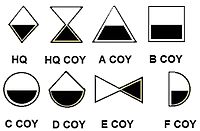Operation Reindeer, which began on 4 May 1978, was South Africa's second major military operation in Angola, the first being Operation Savannah.

32 Battalion was an elite light infantry battalion of the South African Army founded in 1975, composed of black and white commissioned and enlisted personnel. It was disbanded on 26 March 1993.

The South African Defence Force (SADF) comprised the armed forces of South Africa from 1957 until 1994. Shortly before the state reconstituted itself as a republic in 1961, the former Union Defence Force was officially succeeded by the SADF, which was established by the Defence Act of 1957. The SADF, in turn, was superseded by the South African National Defence Force in 1994.

The South West Africa Territorial Force (SWATF) was an auxiliary arm of the South African Defence Force (SADF) and comprised the armed forces of South West Africa from 1977 to 1989. It emerged as a product of South Africa's political control of the territory which was granted to the former as a League of Nations mandate following World War I.
Operation Daisy was a military operation conducted from November 1–20, 1981 by the South African Defence Force and South West African Territorial Force (SWATF) in Angola during the South African Border War and Angolan Civil War. This conflict was sparked when the South African Defence Force decided to try to halt the regroup of the active military branch of SWAPO, also known as the People's Liberation Army of Namibia.
Operation Prone was a proposed military operation by the South African Defence Force (SADF) and South West African Territorial Force (SWATF) during the South African Border War and Angolan Civil War between May and September 1988. With the advance of the 50th Cuban Division towards Calueque and the South-West Africa border, the SADF formed the 10 SA Division to counter this threat. The plan for Operation Prone had two phases. Operation Linger was to be a counterinsurgency phase and Operation Pact a conventional phase.

101 Battalion(pronounced as one-o-one Battalion) was a quick-reaction unit of the South West African Territorial Force, composed of black and white commissioned and enlisted personnel.
Immanuel Hafeni Augustus Shifidi, born in Windhoek, was a Namibian activist. He was one of the fighters at Omugulugwombashe on 26 August 1966 when eight helicopters of the South African Defence Force attacked SWAPO guerrilla fighters at the camp. It was the first armed battle in the Namibian War of Independence.
Operation Boswilger was a military operation executed by the South West Africa Territorial Force in June 1985 during the South African Border War and Angolan Civil War. The SADF soldiers pursued SWAPO's, PLAN insurgents, who had attacked infrastructure, out of South West Africa/Namibia across the border into Angola.

The 44 Pathfinder Platoon is part of the 44 Parachute Regiment. The pathfinder is a trained and specialized paratrooper, who performs covertly behind enemy lines, either in small groups or in collaboration with other reconnaissance units.
Operation Mebos occurred during July and August 1982 with the objective of attacking SWAPO's People's Liberation Army of Namibia (PLAN) bases and new regional headquarters in Southern Angola by the South African Defence Force (SADF) based in South West Africa/Namibia.
Operation Phoenix was an operation in 1983 by the South African Defence Force and South West African Territorial Force in response to a major incursion by PLAN fighters from Angola into the white farming areas of northern South West Africa.
Operation Merlyn was a military operation by the South African Defence Force (SADF), South West African Territorial Force (SWATF) and South West African Police (SWAPOL) during the South African Border War and Angolan Civil War in April 1989. The aim of the operation was to prevent the incursion of PLAN (SWAPO) insurgents into South West Africa/Namibia from bases in Angola. These incursions were in violation of a ceasefire which came into effect on 1 April 1989 via the implementation of United Nations Security Council Resolution 435 and the Tripartite Accord. Initially, these PLAN incursions were tackled by South West African police units and eventually by SADF and SWATF units, released to assist the police having been confined to their bases by the peace agreements. These incursions and the conflict that occurred ended after hastily arranged talks resulted in the Mount Etjo Declaration and an eventual ceasefire.

8 South African Infantry Battalion is a mechanized infantry unit of the South African Army. The battalion is equipped with Ratel Infantry Fighting Vehicles (IFV) used for fast transport and combat mobility across rough ground. Support weapons for mechanized infantry are also provided with motorized transport, or are built directly into these IFVs, in order to keep pace with the IFVs in combat. The battalion was raised at Upington in the Northern Cape on 01 October 1973 as part of the South African Infantry Corps, and since the change in structure, has been assigned to the Infantry Formation.

34 Battalion was a light infantry battalion that was part of the SWATF.

33 Battalion or the Eastern Caprivi Battalion, was a light infantry battalion that was part of the SWATF.

36 Battalion was a light infantry battalion in the South African Army and in later years became part of the SWATF.

102 Battalion(pronounced as one-o-two Battalion) was a quick-reaction unit of the South West African Territorial Force. The battalion lost 36 men.

Regiment Erongo was a quick-reaction unit of the South West African Territorial Force.

South West Africa Command was a command of the South African Army.




















